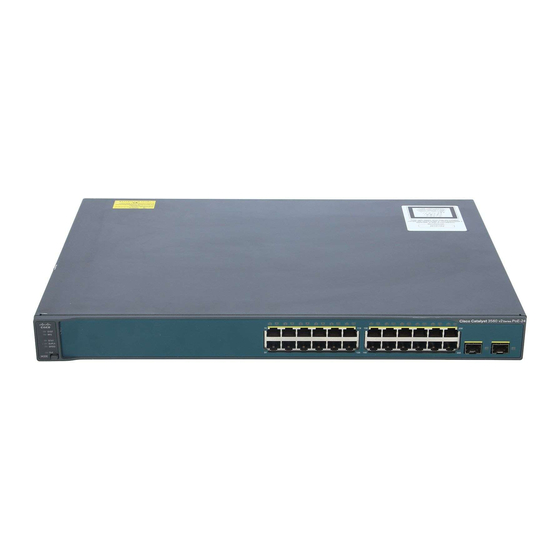Cisco 3560V2 - Catalyst 48 10/100 Poe Fiche technique - Page 9
Parcourez en ligne ou téléchargez le pdf Fiche technique pour {nom_de_la_catégorie} Cisco 3560V2 - Catalyst 48 10/100 Poe. Cisco 3560V2 - Catalyst 48 10/100 Poe 20 pages. Cisco catalyst 3560v2-24ps: specifications

Internet Group Management Protocol v3 (IGMP) Snooping for IPv4 and IPv6 MLD v1 and v2 Snooping
●
provide fast client joins and leaves of multicast streams and limits bandwidth-intensive video traffic to only the
requestors.
IGMP filtering provides multicast authentication by filtering out nonsubscribers and limits the number of
●
concurrent multicast streams available per port.
Multicast VLAN registration (MVR) continuously sends multicast streams in a multicast VLAN while isolating
●
the streams from subscriber VLANs for bandwidth and security reasons.
Source Specific Multicast (SSM) simplifies multicast deployment and optimizes bandwidth for one-to-many
●
applications, such as a corporate video broadcast.
Multicast VRF Lite enables Multicast Virtualization and separation of VRF traffic.
●
EIGRP stub and PIM stub enable multicast and routing on the uplinks, within the IP Base feature set.
●
IGMP Proxy enables the switch to process IGMP client requests, within the IP Base feature set.
●
Cisco IP SLAs allow you to optimize IP business applications, including VoIP, Video, and data, by measuring
●
end-to-end service levels and performance. This feature can be used to monitor performance and to prove
service levels. The IP SLA requestor function requires the IP Services license but the IP SLA responder
function is available within the IP Base license.
Cisco MAC Notification MIB enables you to monitor MAC table utilization and to track end device movements
●
across the network. This feature also allows you to set threshold limits to notify MAC changes.
Advanced QoS
The Cisco Catalyst 3560 v2 series offers superior multilayer, granular QoS features to help ensure that network
traffic is classified and prioritized, and that congestion is avoided in the best possible manner. Configuration of QoS
is greatly simplified through automatic QoS (Auto QoS), a feature that detects Cisco IP phones and automatically
configures the switch for the appropriate classification and egress queuing. Other QoS features include:
Standard 802.1p CoS and DSCP field classification are provided, using marking and reclassification on a per-
●
packet basis by source and destination IP address, source and destination MAC address, or Layer 4 TCP or
UDP port number.
Cisco control- and data-plane QoS ACLs on all ports help ensure proper marking on a per-packet basis.
●
Four egress queues per port enable differentiated management of up to four traffic types.
●
Shaped Round Robin (SRR) scheduling helps ensure differential prioritization of packet flows by intelligently
●
servicing the ingress and egress queues.
Weighted tail drop (WTD) provides congestion avoidance at the ingress and egress queues before a
●
disruption occurs.
Strict priority queuing guarantees that the highest-priority packets are serviced ahead of all other traffic.
●
There is no performance penalty for highly granular QoS functions.
●
IP SLAs allow you to optimize IP business applications for VOIP, Video, and Data by measuring end-to-end
●
service level and performance metrics.
The Cisco Committed Information Rate (CIR) function guarantees bandwidth in increments as low as 8 kbps.
●
Rate limiting is provided based on source and destination IP address, source and destination MAC address,
●
Layer 4 TCP and UDP information, or any combination of these fields, using QoS ACLs (IP ACLs or MAC
ACLs), class maps, and policy maps.
Asynchronous data flows upstream and downstream from the end station or on the uplink are easily managed
●
using ingress policing and egress shaping.
© 2009 Cisco Systems, Inc. All rights reserved. This document is Cisco Public Information.
Data Sheet
Page 9 of 20
